Longfin tetra - Brycinus longipinnis
Scientific name: Brycinus longipinnis
Common name: Longfin tetra
Family: Alestidae
Usual size in fish tanks: 10 - 12 cm (3.94 - 4.72 inch)
014
Recommended pH range: 6 - 8
Recommended water hardness: 5 - 19°N (89.29 - 339.29ppm)
0°C 32°F30°C 86°F
Recommended temperature range: 22 - 26 °C (71.6 - 78.8°F)
The way how these fish reproduce: Spawning
Where the species comes from: Africa
Temperament to its own species: peaceful
Temperament toward other fish species: peaceful
Usual place in the tank: Top levels
General Information
Longfin Tetra (Brycinus longipinnis, syn. Bryconalestes longipinnis) is a vigorous, schooling characin from the Atlantic-draining rivers of West and Central Africa—from The Gambia south/east to the Democratic Republic of the Congo. It inhabits main channels, tributaries, and even estuarine brackish margins. Adults typically reach 10–12 cm TL in aquaria (larger in the wild is reported). This species is active and food-competitive; keep in a group of 6–8 with ample open water for cruising.
Food & Feeding
Omnivorous and unfussy. Use quality flakes or small sinking/pellet foods as the staple, and rotate frozen/live items such as brine shrimp, daphnia, bloodworms, cyclops. Offer modest portions 2–3× daily so timid tank mates aren’t outcompeted. Include some plant matter (spirulina, blanched spinach) for balance. They are reported to be sensitive to chronically high nitrate, so avoid overfeeding.
Sexing
Mature males usually develop more elongated dorsal (and often anal) fins and may be a touch deeper-bodied; females are fuller in the abdomen when gravid. Juveniles are difficult to sex reliably.
Breeding
Group egg scatterer; parental care absent. Use a separate spawning tank with fine-leaved plants/spawning mops and a mesh or marbles so eggs fall out of reach. Condition adults on rich foods; many spawns occur at daybreak. Remove adults post-spawning. Eggs hatch in ~24–48 h; fry become free-swimming a few days later and start on infusoria/rotifers, then newly hatched brine shrimp.
Lifespan
Typically 5–8 years with clean, stable water and a stress-free social group.
Tank Requirements & Water Parameters
- Tank size/footprint: prioritize length and open water; for a school of 6–8 , aim for 120 cm/4 ft length (≈240–300 L) or larger.
- Temperature: 22–26 °C (71.6–78.8 °F).
- pH: 6.0–8.0; hardness: soft–moderately hard (~5–19 °dH). Stability matters more than the exact number.
- Décor & flow: open swimming lanes with planting to sides/back; moderate flow and high oxygenation suit riverine habits.
- Maintenance: weekly water changes (25–40 %) and strong filtration to keep nitrate low.
Compatibility & Tank Mates
Generally peaceful but assertive at feeding. Best with similarly sized, quick mid-water fish (larger tetras/Alestids like Phenacogrammus, Arnoldichthys), robust rasboras/barbs, rainbowfish, and sturdy bottom dwellers (e.g., Synodontis, larger Corydoras). Avoid tiny, very timid, or long-finned slow species that can be outcompeted or stressed.
Behaviour & Usual Place in the Tank
Active shoaler occupying the middle to upper water column. Provide a tight lid—fast dashes at the surface can lead to jumps when startled.
Short Description
Brycinus longipinnis is a sleek West/Central African schooling tetra built for current and distance. Give it space, numbers, and clean, oxygen-rich water; feed a varied omnivorous diet; and expect a dynamic, shimmering display.
Pictures
Bought by aqua-fish.net from jjphoto.dk.
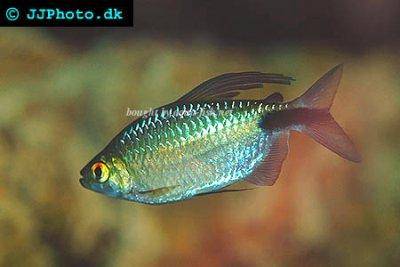



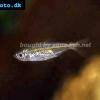 Yellowtail
Yellowtail 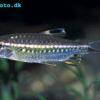 Red
Red 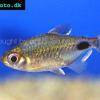 African
African 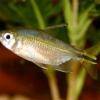 Congo
Congo